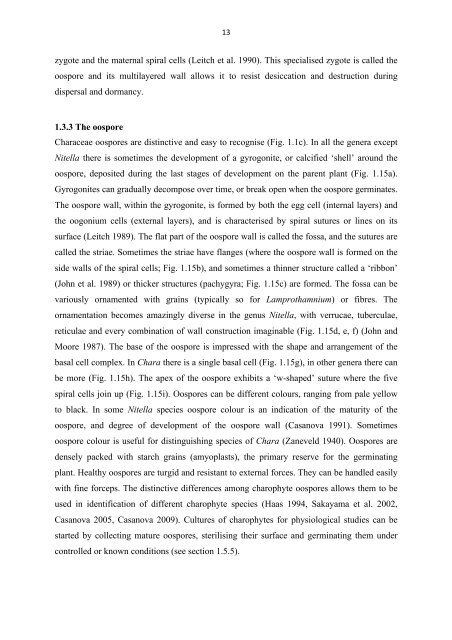Chapter 1: The Characeae Plant
Chapter 1: The Characeae Plant
Chapter 1: The Characeae Plant
You also want an ePaper? Increase the reach of your titles
YUMPU automatically turns print PDFs into web optimized ePapers that Google loves.
13 <br />
zygote and the maternal spiral cells (Leitch et al. 1990). This specialised zygote is called the<br />
oospore and its multilayered wall allows it to resist desiccation and destruction during<br />
dispersal and dormancy.<br />
1.3.3 <strong>The</strong> oospore<br />
<strong>Characeae</strong> oospores are distinctive and easy to recognise (Fig. 1.1c). In all the genera except<br />
Nitella there is sometimes the development of a gyrogonite, or calcified ‘shell’ around the<br />
oospore, deposited during the last stages of development on the parent plant (Fig. 1.15a).<br />
Gyrogonites can gradually decompose over time, or break open when the oospore germinates.<br />
<strong>The</strong> oospore wall, within the gyrogonite, is formed by both the egg cell (internal layers) and<br />
the oogonium cells (external layers), and is characterised by spiral sutures or lines on its<br />
surface (Leitch 1989). <strong>The</strong> flat part of the oospore wall is called the fossa, and the sutures are<br />
called the striae. Sometimes the striae have flanges (where the oospore wall is formed on the<br />
side walls of the spiral cells; Fig. 1.15b), and sometimes a thinner structure called a ‘ribbon’<br />
(John et al. 1989) or thicker structures (pachygyra; Fig. 1.15c) are formed. <strong>The</strong> fossa can be<br />
variously ornamented with grains (typically so for Lamprothamnium) or fibres. <strong>The</strong><br />
ornamentation becomes amazingly diverse in the genus Nitella, with verrucae, tuberculae,<br />
reticulae and every combination of wall construction imaginable (Fig. 1.15d, e, f) (John and<br />
Moore 1987). <strong>The</strong> base of the oospore is impressed with the shape and arrangement of the<br />
basal cell complex. In Chara there is a single basal cell (Fig. 1.15g), in other genera there can<br />
be more (Fig. 1.15h). <strong>The</strong> apex of the oospore exhibits a ‘w-shaped’ suture where the five<br />
spiral cells join up (Fig. 1.15i). Oospores can be different colours, ranging from pale yellow<br />
to black. In some Nitella species oospore colour is an indication of the maturity of the<br />
oospore, and degree of development of the oospore wall (Casanova 1991). Sometimes<br />
oospore colour is useful for distinguishing species of Chara (Zaneveld 1940). Oospores are<br />
densely packed with starch grains (amyoplasts), the primary reserve for the germinating<br />
plant. Healthy oospores are turgid and resistant to external forces. <strong>The</strong>y can be handled easily<br />
with fine forceps. <strong>The</strong> distinctive differences among charophyte oospores allows them to be<br />
used in identification of different charophyte species (Haas 1994, Sakayama et al. 2002,<br />
Casanova 2005, Casanova 2009). Cultures of charophytes for physiological studies can be<br />
started by collecting mature oospores, sterilising their surface and germinating them under<br />
controlled or known conditions (see section 1.5.5).
















